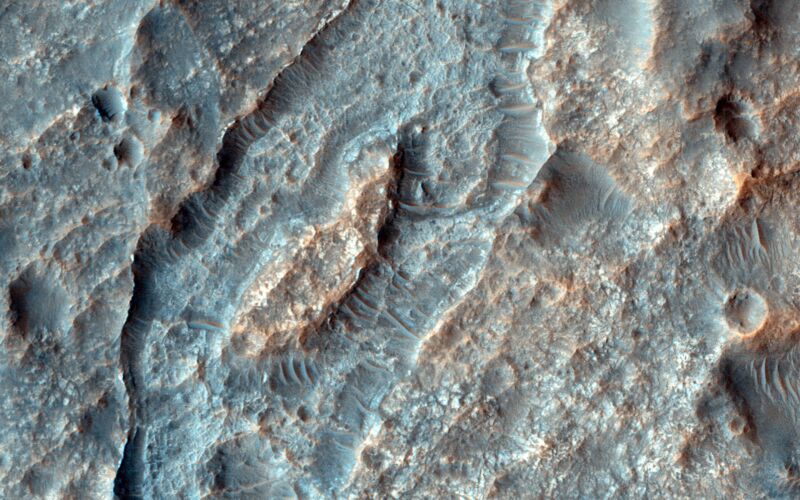
Early in Earth’s history, the heat left over from the collision that formed the Moon left its surface an ocean of magma. As it cooled, its crust was frequently shattered by massive impacts that dwarfed the one that did in the dinosaurs. Somewhere in between that and the onset of plate tectonics, it’s thought that a distinct process caused parts of the crust to sink, while volcanism brought material to the surface that would later form the continental crust.
While we can model this period, we can’t really search for evidence to back our models, since any of this early crust has been eroded or transformed by the plate tectonics that eventually ensued. However, a team of researchers is suggesting that there might be a way to see what this process looked like, and it doesn’t involve a time machine. Instead, it involves studying the surface of Mars.
Lots of volcanoes
On Mars, plate tectonics never got going. So, while some areas of the planet have been transformed in a way that keeps us from studying the earliest periods of Mars’ history—looking at you, Olympus Mons—scientific consensus is that nearly half of the planet’s surface is over 3.6 billion years old. This provides the opportunity to study processes that occurred in the first half-billion or so years after Mars formed.
To do so, a small team of researchers focused on an area called the Eridania Basins, deep depressions in Mars’ southern hemisphere that may once have been home to a lake three times the size of the Caspian Sea. The crust in the area holds the strongest signal of Mars’ early magnetic field, suggesting it might have formed early in the planet’s history when the field was stronger.
The researchers started by cataloging all of the volcanic features in the area; and there were a lot of them—dozens, if not hundreds. Most of these have analogs on Earth: volcanic shields and calderas, debris flows, and stratovolcanoes all make appearances. Some of the volcanic features have properties that suggest they formed while the area was under water, indicating that eruptions took place while the basin was filled by Eridania Lake.
On its own, finding all of these features would be striking. But measurements of the composition of the volcanic material indicate it’s high in what are called felsic materials, meaning rocks like granite. This is in contrast to the basaltic lavas found elsewhere on Mars. “The diverse volcanism is associated with felsic volcanic compositions which are unlike any other suite of recognized deposits or volcanic region on Mars,” the researchers write.
Before plates
Felsic material is less dense than basaltic rocks and is a major component of the continental plates currently found on Earth. Because of its low density, it’s thought to have been preferentially erupted back to the surface early in Earth’s history, driving the process that would ultimately build continents. This process may have involved multiple rounds of enrichment, with mixed material being drawn to the interior of the planet, and progressively less dense material erupted back, building the precursors of Earth’s continents.
Plate tectonics on Earth hadn’t started yet, though, so material had to be cycled into the interior from the surface via some other mechanism. Evidence of that mechanism has also been largely wiped out by subsequent geological activity.
But that hasn’t been the case on Mars. The researchers highlight the deepest portions of the basin, where the crust has both subsided and thinned dramatically. They suggest that this is a case where the base of the crust pulled away from the surface and sank into the planet’s interior. There’s even a site where a single ridge seems to have been pushed upward as three surrounding basins sank.
While this terrain is considered some of the oldest on Mars, the researchers suggest that, with nearly half the planet hosting very old surface features, it’s worth looking at other regions in detail as well. This will hopefully catch other instances of the processes seen here, allowing us a clearer picture of early crust development on rocky planets.
Nature Astronomy, 2024. DOI: 10.1038/s41550-023-02191-7 (About DOIs).

